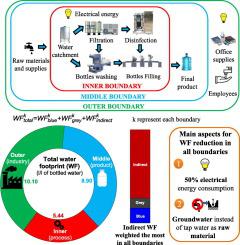Journal of Water Process Engineering ( IF 7 ) Pub Date : 2021-07-21 , DOI: 10.1016/j.jwpe.2021.102199 Juan Martín Mainardi-Remis 1, 2 , Dolores Gutiérrez-Cacciabue 1, 2 , Daniel Sebastián Romero 1, 2 , Verónica Beatriz Rajal 1, 2, 3

|
In this work, the total water involved in a bottled water model plant was estimated. Total water footprint (WF), including blue, grey, and indirect components were calculated for three setting boundaries: inner (process), middle (product) and outer (industry). Total WF was obtained as the sum of the direct (operational) and the indirect (supply chain) WF. Then, five hypothetical scenarios (with regard to the base-case) were examined to find alternatives for WF reduction. In WF terms, total water use involved in the entire plant was 600% higher than the amount directly consumed (blue). The indirect WF component contributed the most to the total in all boundaries (64–78%), due to energy consumption and raw materials. Blue and grey components were the highest in the inner due to bottles filling and detergent use. Hypothetical scenarios showed us that WF values can change among established boundaries, which would directly impact on decision-making, based upon the priorities set by the stakeholders. For example, if business wants to increase production while minimizing water use, it should aim to reduce the WF of the middle boundary. Conversely, if the goal is to reach an environmental and social commitment, the plant should consider reducing the WF of the outer boundary, to reduce the electrical energy usage or to replace tap with groundwater. Defining boundaries for WF calculation is a smart tool to distinguish critical sectors so that business could decide where and how to apply (or not) actions towards more efficient production.
中文翻译:

在瓶装水厂内设置边界有助于更好地可视化用水:通过水足迹指标的一种方法
在这项工作中,估计了瓶装水模型工厂中涉及的总水量。针对三个设置边界计算了总水足迹 (WF),包括蓝色、灰色和间接分量:内部(过程)、中间(产品)和外部(工业)。总 WF 是直接(运营)和间接(供应链)WF 的总和。然后,检查了五个假设情景(关于基本情况)以寻找减少 WF 的替代方案。在 WF 方面,整个工厂涉及的总用水量比直接消耗的量(蓝色)高 600%。由于能源消耗和原材料,间接 WF 部分在所有边界中对总量的贡献最大(64-78%)。由于瓶子填充和洗涤剂的使用,蓝色和灰色成分在内部最高。假设情景向我们展示了 WF 值可以在既定边界之间变化,这将直接影响决策,基于利益相关者设定的优先级。例如,如果企业希望在最大限度减少用水量的同时增加产量,则应致力于减少中间边界的 WF。相反,如果目标是实现环境和社会承诺,工厂应考虑减少外部边界的 WF,减少电能使用或用地下水代替水龙头。为 WF 计算定义边界是区分关键部门的智能工具,以便企业可以决定在何处以及如何应用(或不)行动以提高生产效率。基于利益相关者设定的优先事项。例如,如果企业希望在最大限度减少用水量的同时增加产量,则应致力于减少中间边界的 WF。相反,如果目标是实现环境和社会承诺,工厂应考虑减少外部边界的 WF,减少电能使用或用地下水代替水龙头。为 WF 计算定义边界是区分关键部门的智能工具,以便企业可以决定在何处以及如何应用(或不)行动以提高生产效率。基于利益相关者设定的优先事项。例如,如果企业希望在最大限度减少用水量的同时增加产量,则应致力于减少中间边界的 WF。相反,如果目标是实现环境和社会承诺,工厂应考虑减少外部边界的 WF,减少电能使用或用地下水代替水龙头。为 WF 计算定义边界是区分关键部门的智能工具,以便企业可以决定在何处以及如何应用(或不)行动以提高生产效率。工厂应考虑减少外部边界的 WF,以减少电能使用或用地下水代替水龙头。为 WF 计算定义边界是区分关键部门的智能工具,以便企业可以决定在何处以及如何应用(或不)行动以提高生产效率。工厂应考虑减少外部边界的 WF,以减少电能使用或用地下水代替水龙头。为 WF 计算定义边界是区分关键部门的智能工具,以便企业可以决定在何处以及如何应用(或不)行动以提高生产效率。



























 京公网安备 11010802027423号
京公网安备 11010802027423号